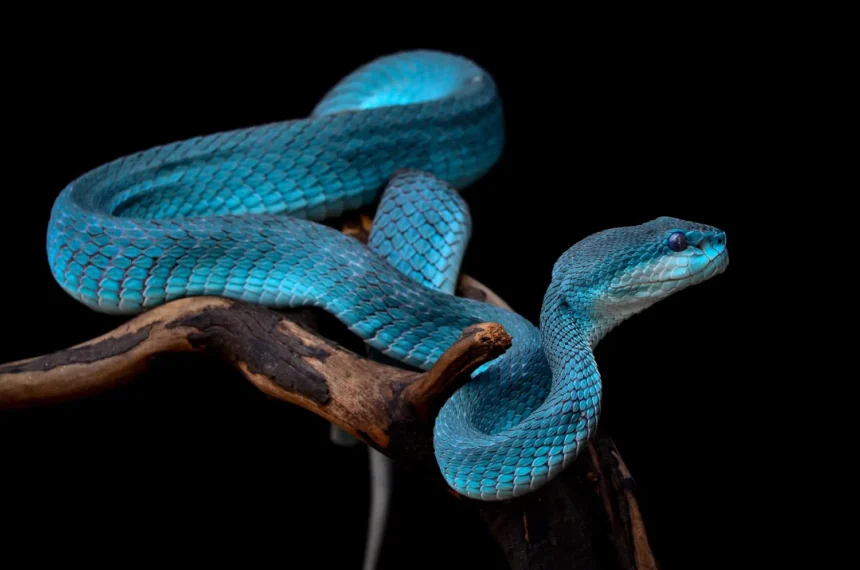⫸ Understanding Snake Venom: The World's Most Venomous Snakes and Their Deadly Arsenal
The world’s most venomous snakes possess a fascinating yet terrifying weapon: venom. This complex cocktail of proteins, enzymes, and other toxins has evolved over millions of years, allowing these predators to subdue prey and defend themselves. Understanding snake venom is crucial for appreciating these creatures’ intricacies and protecting ourselves from their potentially lethal bites.
What Makes a Snake Venomous?
Not all snakes are venomous. Venomous snakes have evolved specialized glands that produce venom, a complex cocktail of proteins, enzymes, and other toxins. These snakes typically possess hollow or grooved fangs, which they use to inject venom into their prey or, in defense, into potential threats. Venom serves multiple purposes for snakes, including:
- Subduing Prey: Venom immobilizes or kills prey animals, making them easier to consume.
- Aiding Digestion: Certain enzymes in venom begin the process of digestion before the prey is even swallowed.
- Defense Mechanism: Venom acts as a deterrent against predators and threats, discouraging attacks.
Types of Snake Venom and Their Effects
Snake venom is a complex mixture; its specific components determine its effects on the victim. The world’s most venomous snakes generally produce one of two main types of venom:
- Neurotoxic Venom: This type primarily targets the nervous system, disrupting the transmission of nerve signals. Symptoms can include paralysis, difficulty breathing, and even respiratory failure. Snakes with predominantly neurotoxic venom include the Inland Taipan, Black Mamba, and King Cobra.
- Hemotoxic Venom: This venom attacks the circulatory system, causing blood clotting abnormalities, tissue damage, and organ failure. Symptoms can include severe pain, swelling, bleeding, and necrosis (tissue death). Vipers like the Saw-Scaled Viper and Russell’s Viper are known for their hemotoxic venom.
- Cytotoxic venom: Destroys cells and tissues, resulting in localized pain, swelling, and necrosis.
Some venomous snakes possess venom that combines both neurotoxic and hemotoxic properties, resulting in a more complex and potentially devastating array of symptoms. The potency of venom also varies significantly among species, with some snakes, like the Inland Taipan, possessing venom so potent that a single bite can potentially kill dozens of adult humans.
In the following sections, we will delve into the specific venoms of the top 12 deadliest snakes on Earth, exploring their unique compositions and the horrifying effects they can have on the human body.
⫸ The Deadliest Snakes on Earth: A Look at the World's Most Venomous Snakes
The world’s most venomous snakes aren’t just characters in a horror movie. They’re real, lethal, and inhabit every continent except Antarctica. While most snakes are harmless or beneficial to ecosystems, a select few have evolved potent venom that can quickly take down prey – or, in rare cases, humans.
This section of our guide takes you on a journey to meet these deadly serpents. We’ll explore their unique adaptations, preferred habitats, and the science behind their devastating venom. You’ll learn about the infamous Inland Taipan, whose single bite contains enough venom to kill 100 people, and the lightning-fast Black Mamba, feared across Africa for its aggression and potent neurotoxins.
Inland Taipan (Oxyuranus microlepidotus)
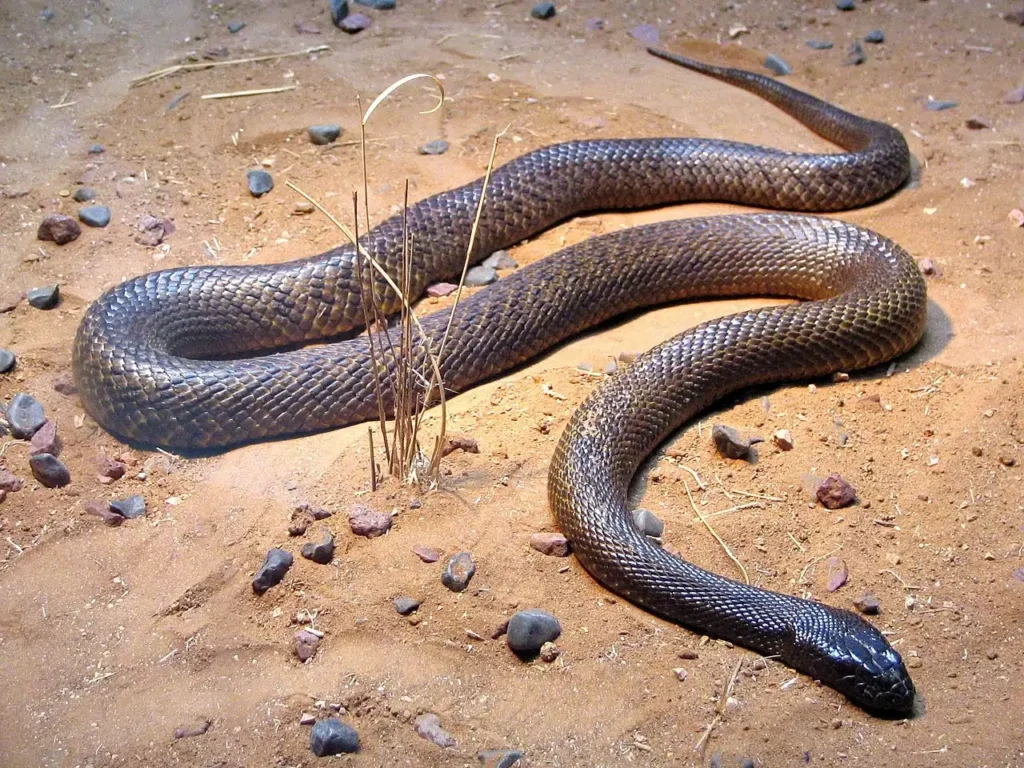
The Inland Taipan, often dubbed the “fierce snake,” holds the grim title of the world’s most venomous snake. Its bite delivers a potent cocktail of toxins that can swiftly incapacitate prey and, without immediate treatment, prove fatal to humans.
Habitat and Distribution:
- Location: Exclusive to the sunbaked landscapes of central-eastern Australia.
- Habitat: Thrives in arid and semi-arid regions, favoring cracked clay plains, gibber deserts, and black soil floodplains.
- Behavior: Primarily diurnal, retreating to abandoned animal burrows or deep soil fissures for shelter.
Venom Potency and Effects:
- Lethality: Boasts the lowest recorded lethal dose (LD50) of any snake, with a mere 0.025mg/kg enough to prove fatal.
- Venom Composition: A complex cocktail of neurotoxins (paralyzing the nervous system), myotoxins (damaging muscle tissue), and procoagulants (disrupting blood clotting).
- Rapid Action: Venom acts swiftly, often causing symptoms within minutes.
Bite Symptoms and Treatment:
- Initial Symptoms: Severe headache, nausea/vomiting, abdominal pain, collapse, convulsions, paralysis, and internal bleeding.
- Rapid Progression: Without treatment, death can occur within 45 minutes but typically takes several hours.
- Neurological symptoms: Progressive paralysis, difficulty breathing, blurred vision, and seizures may follow.
- Systemic effects: If left untreated, the venom can lead to kidney failure, heart arrhythmias, and, ultimately, death.
- Antivenom: Prompt administration of Taipan antivenom is crucial for survival.
Eastern Brown Snake (Pseudonaja textilis)
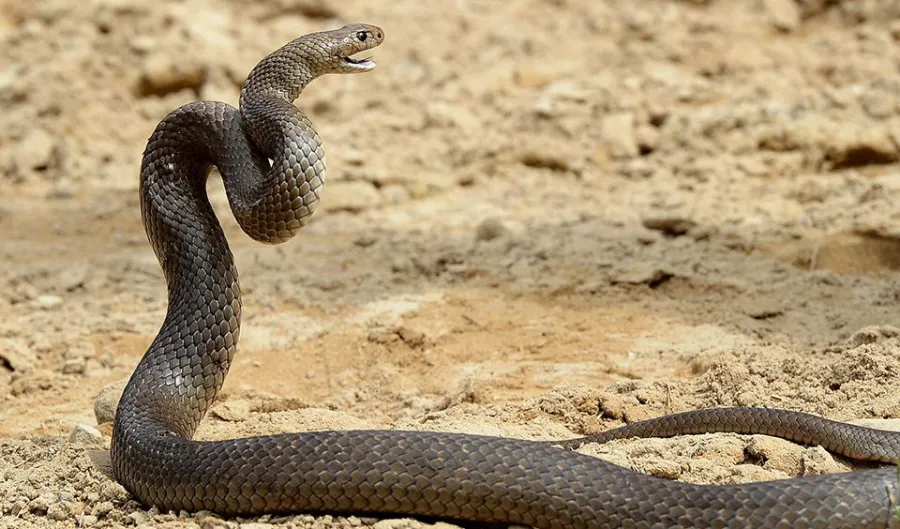
Ranking as the second most venomous land snake globally, the Eastern Brown Snake is a formidable presence in Australia. Its adaptability and potent venom make it a significant threat, but understanding its behavior and effects can help mitigate the risk of deadly encounters.
Habitat and Distribution:
- Location: Widely distributed across eastern and central Australia and parts of southern New Guinea.
- Habitat: Thrives in diverse environments, including grasslands, woodlands, scrublands, and farmland. Often found near human habitation due to the presence of rodents.
- Behavior: Diurnal and highly active, known for its agility and speed. When threatened, it often displays a defensive posture, raising its body and flattening its neck.
Venom Potency and Effects:
- LD50: The subcutaneous LD50 value in mice is 0.053 mg/kg, indicating high toxicity.
- Venom Composition: Predominantly neurotoxic but also contains procoagulants and mycotoxins.
- Effects: Neurotoxins disrupt nerve transmission, leading to paralysis. Procoagulants cause blood clotting abnormalities, while mycotoxins damage muscle tissue.
Bite Symptoms and Treatment:
- Immediate Symptoms: Rapid onset of headache, dizziness, abdominal pain, vomiting, diarrhea, convulsions, and collapse.
- Delayed Symptoms: Kidney damage, paralysis, and, in severe cases, death.
- Treatment: Prompt administration of specific brown snake antivenom is crucial. Pressure immobilization bandages and seeking immediate medical help are essential steps.
Key Points:
- The Eastern Brown Snake, with its widespread distribution and potent venom, is a leading cause of snakebite fatalities in Australia.
- Although its venom is less potent than that of the Inland Taipan, its widespread distribution and encounters with humans increase the risk of fatalities.
- Education and awareness about snake behavior are crucial for preventing snakebites.
- Prompt medical attention and antivenom administration are the only effective treatments for Eastern Brown Snake envenomation.
Coastal Taipan (Oxyuranus scutellatus)
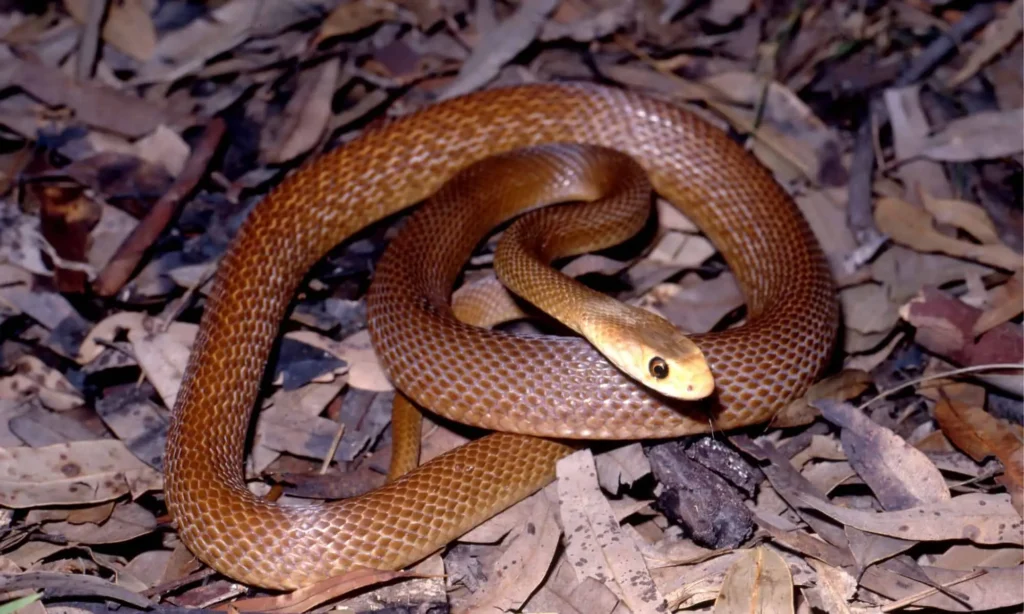
Sharing a genus with the Inland Taipan, the Coastal Taipan is another contender for the world’s deadliest snake title. Though its venom is slightly less toxic than its inland relative, the Coastal Taipan’s larger size, aggressive demeanor, and coastal habitat make it a significant threat to humans.
Habitat and Distribution:
- Location: Found along Australia’s eastern and northern coastlines, extending into parts of New Guinea.
- Habitat: Prefers coastal regions, dunes, woodlands, and sugarcane fields. Often found near water sources.
- Behavior: It is diurnal and highly active, known for its speed and agility. It tends to be more aggressive than the Inland Taipan, readily striking when disturbed.
Venom Potency and Effects:
- LD50: The subcutaneous LD50 in mice is 0.099 mg/kg, indicating extreme toxicity.
- Venom Composition: Contains potent neurotoxins, myotoxins, and procoagulants.
- Effects: Neurotoxins paralyze the nervous system, myotoxins cause muscle damage, and procoagulants disrupt blood clotting, leading to internal bleeding.
Bite Symptoms and Treatment:
- Immediate Symptoms: Severe headache, nausea, vomiting, abdominal pain, collapse, convulsions, and paralysis.
- Delayed Symptoms: Kidney failure, respiratory failure, and death.
- Treatment: Immediate administration of Taipan antivenom is crucial. Pressure immobilization bandages and rapid transport to a medical facility are essential.
Key Points:
- The Coastal Taipan is responsible for many snakebite fatalities in Australia.
- Its venom is among the fastest-acting snake venoms, making rapid treatment essential.
- The Coastal Taipan’s coastal habitat and proximity to human populations increase the risk of encounters.
- Increased awareness of the snake’s presence and appropriate first aid measures can save lives.
Black Mamba (Dendroaspis polylepis)

The Black Mamba, a serpent renowned across Africa and beyond, is a fascinating creature shrouded in myth and fear. As Africa’s longest venomous snake, it has earned a formidable reputation for its impressive swiftness, potent venom, and perceived aggression. While its name suggests a dark coloration, the Black Mamba’s scales often range from earthy tones of olive and brown to cooler shades of grey. Its most distinctive feature, however, is the inky black interior of its mouth, a stark contrast to its exterior that has further solidified its legendary status.
Habitat and Distribution:
- Location: Found in sub-Saharan Africa, ranging from southern Sudan and Ethiopia to South Africa.
- Habitat: Inhabits savannas, rocky slopes, woodlands, and occasionally dense forests.
- Behavior: Primarily terrestrial (ground-dwelling), it can also climb trees. It is known for its speed and can move up to 12 miles per hour in short bursts.
Venom Potency and Effects:
- LD50: Subcutaneous LD50 in mice is approximately 0.25 mg/kg, indicating high toxicity.
- Venom Composition: Predominantly neurotoxic, affecting the nervous system. It also contains cardiotoxins, which affect the heart, and fasciculins, which cause severe muscle twitching.
- Effects: Neurotoxins cause paralysis, while cardiotoxins can lead to cardiac arrest. Fasciculins contribute to the rapid onset of symptoms.
Bite Symptoms and Treatment:
- Immediate Symptoms include tingling in the mouth and extremities, blurred vision, dizziness, fever, excessive salivation, difficulty swallowing, and respiratory system paralysis.
- Delayed Symptoms: Without treatment, death can occur within 20 minutes to 3 hours.
- Treatment: The only effective treatment is the immediate administration of Black Mamba antivenom.
Key Points:
- The Black Mamba is one of the most venomous snakes in the world and one of the fastest-acting.
- Despite its reputation, the Black Mamba is generally shy and avoids confrontation with humans. However, it will bite if threatened or cornered.
- Due to its potent venom and the rapid onset of symptoms, a Black Mamba bite is a medical emergency requiring immediate treatment.
King Cobra (Ophiophagus Hannah)
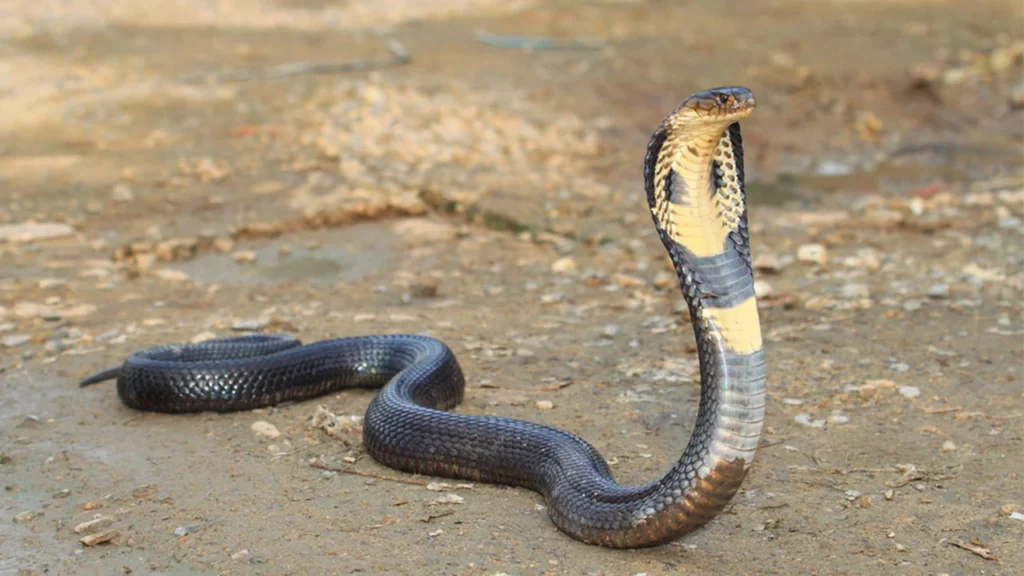
The king cobra is an impressive and formidable reptile. It holds the undisputed title of the world’s longest venomous snake, capable of growing to an astonishing 18 feet in length. Its imposing size, potent venom, and unique behavior make it a fascinating creature. Despite its name, it’s not a “true” cobra but a distinct species with its genus.
Habitat and Distribution:
- Location: Found in Southeast Asia, spanning India, China, Indonesia, and the Philippines.
- Habitat: Inhabits dense forests, bamboo thickets, and areas near water sources like rivers and streams.
- Behavior: It is diurnal and predominantly terrestrial, although it’s also an adept climber and swimmer. It is known for its intelligence and complex social interactions.
Venom Potency and Effects:
- LD50: Varies depending on the testing method but is generally considered highly potent.
- Venom Composition: It is primarily neurotoxic, affecting the nervous system. It also contains cytotoxins and cardiotoxins that damage tissues and the heart.
- Effects: Causes rapid paralysis, leading to respiratory failure and death. Other symptoms include blurred vision, vertigo, drowsiness, and difficulty swallowing.
Bite Symptoms and Treatment:
- Immediate Symptoms: Severe pain, local swelling, blurred vision, dizziness, drowsiness, and paralysis.
- Delayed Symptoms: Respiratory failure, cardiovascular collapse, and coma.
- Treatment: Prompt administration of King Cobra antivenom is essential. Supportive care, including mechanical ventilation, may be necessary.
Key Points:
- The King Cobra is an ophiophagus, which primarily preys on other snakes, including venomous species.
- It’s known for its distinctive hood, flares when threatened, and the hissing sound it produces through its respiratory system.
- While not typically aggressive towards humans, it will defend itself if cornered or provoked.
- The venom of a King Cobra, one of the largest venomous snakes, can quickly become lethal due to its immense size and the potency of its neurotoxic venom.
- Conservation efforts are vital for protecting this iconic species and its habitat.
Saw-Scaled Viper (Echis Carinatus)
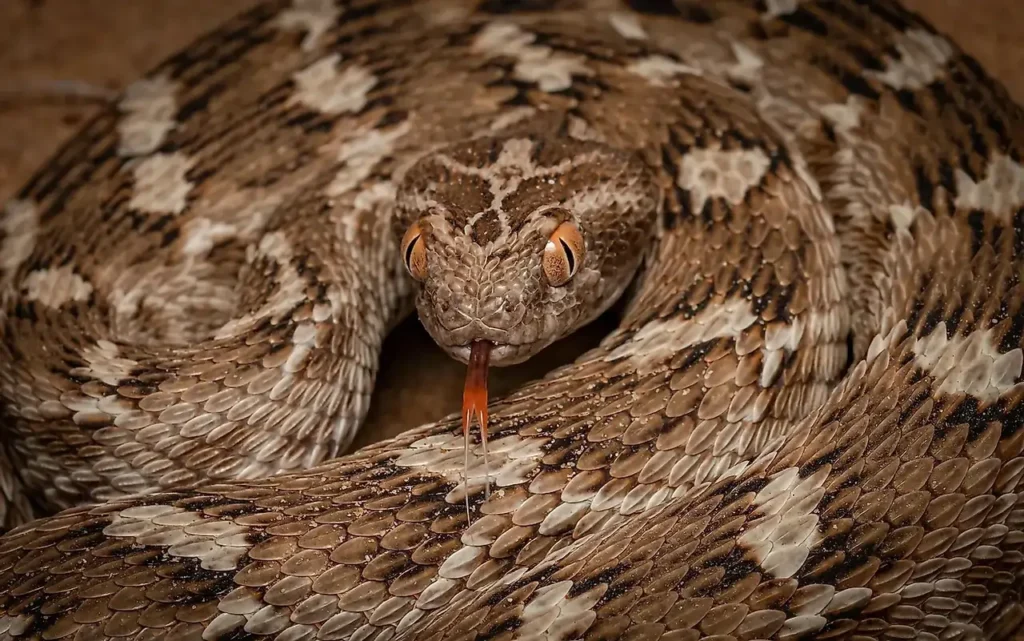
The Saw-Scaled Viper may be small, but its venom is powerful. Responsible for more human deaths than other snake species, this viper is a significant threat in its native range.
Habitat and Distribution:
- Location: Found in dry regions across Africa, the Middle East, and India.
- Habitat: It favors arid environments like deserts, rocky outcrops, and dry grasslands. It is often found near human settlements.
- Behavior: Primarily nocturnal, active during the cooler hours. When threatened, it creates a distinctive hissing sound by rubbing its scales together, warning potential predators.
Venom Potency and Effects:
- LD50: It varies depending on the subspecies but generally ranges from 0.44 mg/kg to 0.75 mg/kg in mice.
- Venom Composition: Predominantly a hemotoxin, disrupting blood clotting and causing extensive internal bleeding.
- Effects: Causes severe pain, swelling, blistering, necrosis (tissue death) around the bite site, and widespread internal bleeding.
Bite Symptoms and Treatment:
- Immediate Symptoms: Sharp pain, swelling, and bleeding at the bite site. Nausea, vomiting, abdominal pain, and headache can also occur.
- Delayed Symptoms: Bleeding from the gums, nose, and internal organs. Kidney failure, shock, and death can occur in severe cases.
- Treatment: Immediate administration of specific antivenom is essential. Blood transfusions and supportive care may be required to manage complications.
Key Points:
- The Saw-Scaled Viper’s small size and camouflage make it difficult to spot, increasing the risk of accidental encounters.
- The viper’s defensive behavior and potent venom contribute to its high mortality rate.
- Education on snake awareness and avoiding potential habitats is crucial in preventing bites.
- Prompt medical attention and antivenom administration are the only effective treatments for Saw-Scaled Viper envenomation.
Russell's Viper (Daboia Russelii)
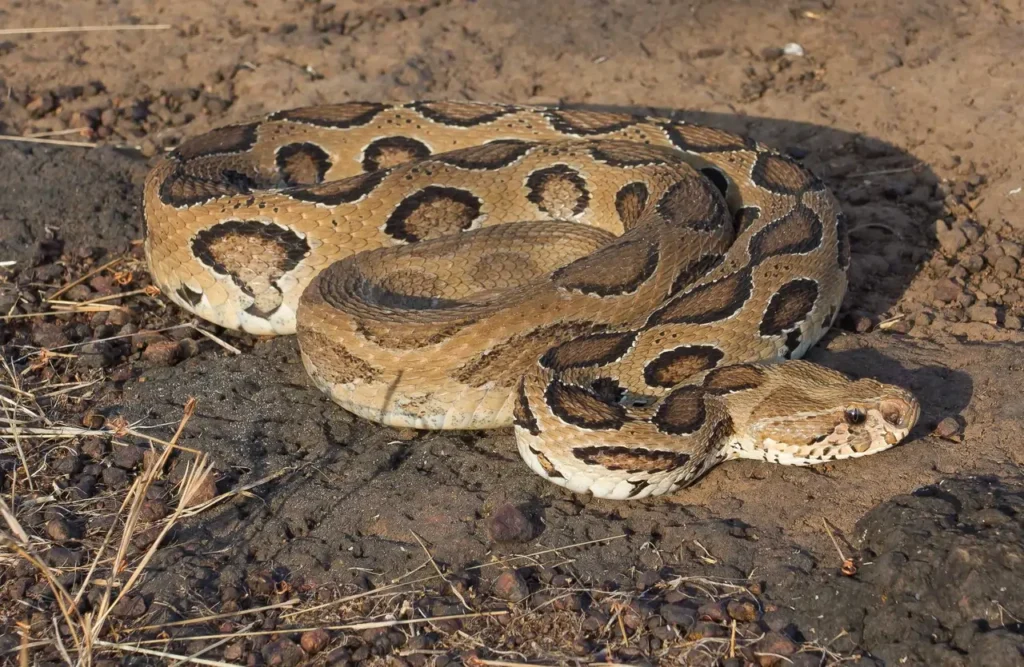
Responsible for many snakebite fatalities in South Asia, the Russell’s Viper is a deceptively beautiful but highly venomous snake. Its potent venom and proximity to human populations make it a significant public health concern.
Habitat and Distribution:
- Location: It is primarily found across the Indian subcontinent, including India, Pakistan, Sri Lanka, Bangladesh, and parts of Southeast Asia.
- Habitat: It favors open grasslands, scrublands, and agricultural fields. Due to the abundance of rodents, it is often found near human settlements.
- Behavior: Largely nocturnal, Russell’s Vipers are ambush predators, lying in wait for unsuspecting prey. They are known for their irritable temperament and defensive strikes when threatened.
Venom Potency and Effects:
- LD50: The subcutaneous LD50 value ranges from 0.12 to 0.75 mg/kg, indicating high toxicity.
- Venom Composition: Contains a complex mixture of hemotoxins and cytotoxins.
- Effects: Hemotoxins disrupt blood clotting, causing internal bleeding and organ damage. Cytotoxins destroy cells and tissues, leading to severe pain and swelling.
Bite Symptoms and Treatment:
- Immediate Symptoms: Intense pain, swelling, blistering, and bleeding at the bite site. Nausea, vomiting, abdominal pain, and hypotension may also occur.
- Delayed Symptoms: Kidney failure, hemorrhage, and shock.
- Treatment: Immediate administration of Russell’s Viper antivenom is crucial for survival. Supportive care, including blood transfusions and dialysis, may be necessary to manage complications.
Key Points:
- The Russell’s Viper significantly contributes to snakebite mortality in its range, particularly among agricultural workers and rural populations.
- Its venom is highly potent and can lead to severe systemic complications if not treated promptly.
- Public health initiatives to raise awareness and provide access to antivenom are essential for reducing the impact of Russell’s Viper bites.
Tiger Snake (Notechis Scutatus)
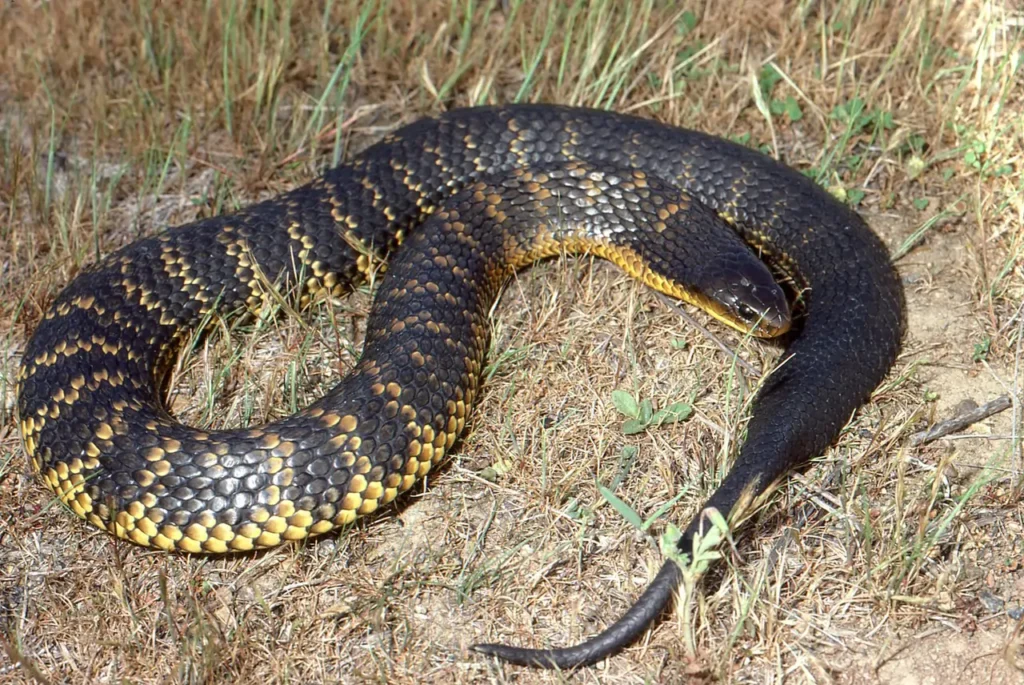
The Tiger Snake, renowned for its distinctive banded patterns, is one of Australia’s most feared and recognizable venomous snakes. Its highly potent venom and adaptable nature make it a significant threat in various regions nationwide.
Habitat and Distribution:
- Location: Found throughout southern and eastern Australia, including Tasmania and some offshore islands.
- Habitat: Adaptable to various environments, including coastal areas, wetlands, grasslands, and forests.
- Behavior: They are primarily diurnal but can be active at night in warmer weather. They are known for their defensive display, flattening their bodies and hissing loudly when threatened.
Venom Potency and Effects:
- LD50: Subcutaneous LD50 in mice is estimated at 0.131 mg/kg, indicating high toxicity.
- Venom Composition: Contains a complex mixture of neurotoxins, myotoxins, and coagulants.
- Effects: Neurotoxins disrupt nerve transmission, leading to paralysis. Myotoxins cause severe muscle damage, and coagulants affect blood clotting.
Bite Symptoms and Treatment:
- Immediate Symptoms: Localized pain and swelling, tingling or numbness around the bite site, headache, nausea, vomiting, sweating, difficulty breathing, and paralysis.
- Delayed Symptoms: Kidney failure, rhabdomyolysis (muscle breakdown), and, in severe cases, death.
- Treatment: Immediate administration of Tiger Snake antivenom is essential. Pressure immobilization bandages and prompt medical attention are crucial steps in ensuring a positive outcome.
Key Points:
- They are responsible for numerous snakebites in Australia, although fatality rates are relatively low due to effective antivenom.
- Tiger Snakes play a vital role in controlling rodent populations in their ecosystems.
- Familiarizing yourself with the habits of venomous snakes and taking necessary safety measures in their habitats can significantly minimize the chances of a dangerous encounter.
Death Adder (Acanthophis Antarcticus)
Despite its name, the Death Adder isn’t a true adder but belongs to the family Elapidae, making it a relative of cobras and mambas. Known for its ambush predator tactics and potent venom, the Death Adder is a significant player in Australia’s venomous snake roster.
Habitat and Distribution:
- Location: Found throughout most of Australia, excluding Tasmania.
- Habitat: It favors various environments, including forests, grasslands, woodlands, and scrublands. It is often found in sandy or loose soil areas.
- Behavior: Primarily nocturnal, they are masters of camouflage, blending seamlessly with their surroundings. They use a worm-like lure on their tails to attract prey.
Venom Potency and Effects:
- LD50: The LD50 in mice for the Death Adder is 0.4-0.5 mg/kg.
- Venom Composition: Neurotoxic, with some myotoxic properties.
- Effects: Neurotoxins rapidly cause paralysis, including respiratory paralysis, leading to death if untreated. Myotoxins can cause muscle damage.
Bite Symptoms and Treatment:
- Immediate Symptoms: Sudden onset of pain, swelling, and tenderness at the bite site, followed by headache, drowsiness, nausea, vomiting, and difficulty breathing.
- Delayed Symptoms: Paralysis, respiratory failure, and death.
- Treatment: Immediate administration of Death Adder antivenom is critical. Pressure immobilization bandages and urgent medical attention are essential.
Key Points:
- The Death Adder is responsible for a significant number of snakebites in Australia, although fatalities are less common due to the availability of antivenom.
- Its ambush predation strategy and effective camouflage make it a dangerous snake.
- Quick medical intervention and antivenom administration are key to surviving a Death Adder bite.
Beaked Sea Snake (Enhydrina Schistosa)
Lurking beneath the ocean’s surface, the Beaked Sea Snake is a venomous marvel of the marine world. Though rarely encountering humans, its potent venom and aggressive nature make it a formidable member of the world’s most venomous snake list.
Habitat and Distribution:
- Location: This species thrives in the tropical coastal waters of the Indo-Pacific region, spanning an expansive area from the Persian Gulf to the northern shores of Australia.
- Habitat: It prefers shallow coastal waters, including estuaries, mangroves, and coral reefs. It is often found in murky waters or near river mouths.
- Behavior: Primarily diurnal (active during the day), mostly hunting for fish.
Venom Potency and Effects:
- LD50: Averages around 0.16 mg/kg, indicating high toxicity.
- Venom Composition: Predominantly neurotoxic but also contains mycotoxins.
- Effects: Neurotoxins disrupt nerve signals, leading to paralysis. Myotoxins cause severe muscle damage and breakdown.
Bite Symptoms and Treatment:
- Immediate Symptoms: There is usually minimal pain at the bite site, but progressive muscle aches and stiffness develop. Difficulty swallowing, droopy eyelids, and blurred vision may occur.
- Delayed Symptoms: Paralysis can progress rapidly, leading to respiratory failure and death within hours if untreated.
- Treatment: Immediate administration of sea snake antivenom is essential. Respiratory failure may necessitate interventions like mechanical ventilation to support breathing and maintain oxygenation.
Key Points:
- The beaked sea snake, prevalent in its habitat, possesses venom potent enough to classify it among the most dangerous of its marine counterparts.
- Its small fangs and painless bite can lead to delayed recognition of envenomation, making prompt treatment crucial.
- While encounters with humans are rare, fishermen and divers in its range should exercise caution.
- Current studies on the venom of sea snakes are opening up new possibilities for innovative medical treatments.
Philippine Cobra (Naja Philippinensis)
The northern Philippines is home to the Philippine Cobra, a highly venomous elapid species found nowhere else. Renowned for its ability to spit venom accurately over considerable distances, it poses a significant threat to humans and animals alike.
Habitat and Distribution:
- Location: Found on the islands of Luzon, Mindoro, Catanduanes, and Masbate in the Philippines.
- Habitat: Thrives in various environments, including grasslands, jungles, forests, and agricultural fields. Often found near water sources.
Venom Potency and Effects:
- LD50: 0.2 mg/kg, indicating high toxicity.
- Venom Composition: Primarily neurotoxic, it also contains cytotoxins that cause tissue damage.
- Effects: Neurotoxins disrupt nerve signals, leading to paralysis, respiratory failure, and death—cytotoxins cause pain, swelling, and necrosis at the bite site.
Bite Symptoms and Treatment:
- Immediate Symptoms: Severe pain, swelling, and redness at the bite site. Difficulty breathing, swallowing, and speaking. Nausea, vomiting, abdominal pain, and blurred vision.
- Delayed Symptoms: Respiratory paralysis, cardiovascular collapse, and coma.
- Treatment: Immediate administration of Philippine Cobra antivenom is essential. Supportive care includes respiratory assistance, wound care, and management of complications.
Key Points:
- The Philippine Cobra is a highly aggressive species responsible for numerous snakebite fatalities in the Philippines.
- Its ability to spit venom accurately over several meters increases the risk of envenomation.
- Avoiding contact with this snake and seeking immediate medical attention in case of a bite is crucial for survival.
Western Diamondback Rattlesnake (Crotalus Atrox)
Though not the most venomous snake on our list, the Western Diamondback Rattlesnake earns its place due to its widespread distribution, potent venom, and frequent encounters with humans. A true icon of the American Southwest, this rattlesnake demands respect and caution.
Habitat and Distribution:
- Location: It is native to the southwestern United States (Arizona, California, New Mexico, and Texas) and northern Mexico.
- Habitat: It thrives in diverse environments, including deserts, grasslands, rocky hillsides, and even coastal areas. Due to prey availability, it is often found near human habitation.
Venom Potency and Effects:
- LD50: The subcutaneous LD50 value in mice ranges from 1.24 to 2.76 mg/kg, indicating moderate to high toxicity.
- Venom Composition: Primarily hemotoxic, affecting blood cells and tissue, but also contains neurotoxins.
- Effects: Causes severe pain, swelling, tissue damage, blood clotting abnormalities, and, in severe cases, organ failure.
Bite Symptoms and Treatment:
- Immediate Symptoms: Intense pain, swelling, discoloration at the bite site, nausea, vomiting, tingling, muscle weakness, and difficulty breathing.
- Delayed Symptoms: Hemorrhaging, shock, kidney failure, and potentially death.
- Treatment: Immediate administration of Crotalidae Polyvalent Immune Fab (CroFab) antivenom is crucial. Pressure immobilization and seeking medical attention are vital.
Key Points:
- It’s responsible for the most snakebite fatalities in the United States.
- The Western Diamondback Rattlesnake is a loud rattle that serves as a warning, but bites can occur if the snake feels threatened or cornered.
- Understanding its behavior and taking precautions can minimize the risk of dangerous encounters.
- Prompt medical attention and antivenom treatment are the best chances for survival after a bite.
⫸ Snakebite Prevention and Safety
Although the planet’s deadliest snakes present a danger, knowing their habits and basic preventative measures can substantially lower the chances of encountering them and being bitten.
How to Avoid Snake Encounters
- Be aware of your surroundings: Research the types of snakes found in your area and their habitats. Pay extra attention when hiking or walking in areas where snakes are known to live.
- Wear appropriate clothing: When venturing into snake territory, wear long pants, sturdy boots, and thick socks to protect your legs and ankles.
- Make noise: Snakes possess a keen sense of vibrations, so generating noise while hiking can signal your approach and allow them to retreat peacefully.
- Stick to trails: Avoid tall grass, dense vegetation, and rocky areas where snakes may hide.
- Be cautious when lifting objects: Snakes seek shelter under rocks, logs, or debris. Use a stick to lift objects and check for snakes before reaching underneath.
- Leave snakes alone: When facing a snake, maintain a safe distance and avoid any actions that may agitate or startle it. In most cases, snakes will choose to move away if unprovoked.
What to Do if a Snake Bites You
- Stay calm: Panicking can raise your heart rate and spread venom faster.
- Immobilize the affected limb: Keep the bitten area still and level with your heart.
- Remove constrictive clothing or jewelry: Swelling may occur rapidly.
- Call for emergency medical help: Describe the snake, if possible, and the circumstances of the bite.
- Clean the wound: Gently clean the wound with water and soap.
- Note the time of the bite: This information is vital for medical professionals.
- Do not attempt to suck out the venom, apply a tourniquet, or cut the wound: These actions can worsen the injury and are not recommended.
Key Points:
- Most snakebites occur when people accidentally step on or disturb a snake.
- Time is of the essence when treating snakebite. Immediate medical attention is crucial.
- Do not try to capture or kill the snake. Focus on your safety and getting help.
By following these safety guidelines, you can avoid your risk of encountering venomous snakes and know how to respond if a bite occurs.
⫸ Fascinating Facts About Venomous Snakes
The world’s most venomous snakes aren’t just dangerous and incredibly fascinating creatures with unique adaptations and surprising behaviors. Let’s debunk some common myths and uncover intriguing truths about these remarkable reptiles.
Unique Adaptations
- Specialized Fangs: Venomous snakes have evolved hollow or grooved fangs to deliver their venom efficiently.
- Heat-Sensing Pits: Some venomous snakes, like pit vipers, possess heat-sensing pits on their faces, allowing them to detect warm-blooded prey even in complete darkness.
- Venom Variation: Venom composition varies widely among species, targeting different physiological systems in prey (e.g., nervous system, circulatory system).
Debunking Myths
- All Snakes Are Venomous: False. The majority of snake species are non-venomous and pose no threat to humans.
- Venomous Snakes Are Aggressive: False. Most venomous snakes are shy and prefer to avoid confrontation. They typically only bite when they feel threatened or cornered.
- Brightly Colored Snakes Are Always Venomous: False. While some venomous snakes are brightly colored, others are camouflaged to blend in with their surroundings. Coloration is not a reliable indicator of venomosity.
Key Points:
- Venomous snakes play a crucial role in ecosystems by controlling rodent populations.
- Their venom has inspired numerous medical breakthroughs, including treatments for high blood pressure, heart attacks, and chronic pain.
- Respect and understanding are key to coexisting safely with these fascinating creatures.
⫸ Conclusion: Respecting Nature's Deadly Beauties
Our exploration of the world’s most venomous snakes reveals a chilling yet captivating facet of the natural world. Armed with potent venom and specialized adaptations, these creatures are not monsters to be feared but marvels to be understood and respected.
Key Takeaways:
- Venomous snakes play vital roles in ecosystems, controlling prey populations and maintaining ecological balance.
- Human encounters with these snakes are often accidental, driven by habitat encroachment and a lack of awareness.
- Prevention and education are key to minimizing snakebite risks. Understanding snake behavior, wearing protective gear in snake-prone areas, and seeking professional help for removal are essential measures.
- Prompt medical attention and antivenom administration can save lives. Timely intervention is crucial in treating venomous snakebites.
As we admire these venomous serpents’ intricate beauty and evolutionary marvels, let us remember the importance of coexisting with them responsibly. By respecting their habitats, practicing caution, and seeking knowledge, we can ensure a safer and more harmonious relationship with these deadly beauties of the natural world.
⫸ References:
- Le serpent le plus venimeux au monde – The Explorers. https://theexplorers.com/photo/le-serpent-le-plus-venimeux-au-monde/fr
- Coastal Taipan – https://a-z-animals.com/animals/coastal-taipan/
- Eastern brown snake – https://www.australiangeographic.com.au/fact-file/fact-file-eastern-brown-snake-pseudonaja-textilis/
- King Kobra Image – https://abc13.com/king-cobra-snake-missing-on-the-loose/967956/
- Saw-Scaled Viper Image- https://www.worldatlas.com/animals/deadliest-snake-in-the-world.html
- Russell’s Viper – https://rahulalvares.com/2015/06/the-russells-viper/

